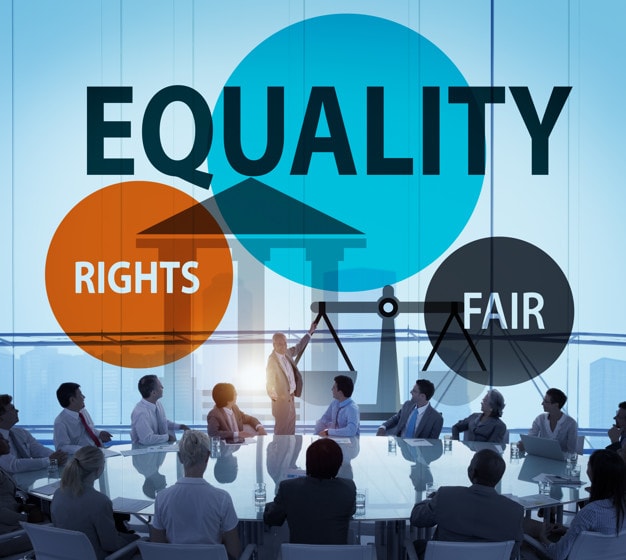One of the most simple pay equity definitions is equal pay for work of equal value. Pay Equity is the level to which the employee’s pay matches what he thinks he deserves. Equity in pay is a practice of eliminating wage inequalities based on gender and race.
Table of Contents
What does Pay Equity mean?
Every employee has a right to equity in pay for equal work, but the truth of the matter is quite different. What a person expects and what he gets are two different things.
The existence of pay discrimination based on race and gender has been a way of life for a very long time. In recent years governments have woken up to the fact that it is wrong and started establishing laws and regulations to eliminate the discrepancies in the pay gap. The most important laws of the pay equity act are
- Equal Pay Act of 1963 – It categorically states that women and men will be provided with equal pay for equal work in the same organization. As per the EEOC, it is not job title but job content that will determine if jobs are equal or not
- Title VII of the Civil Rights Act of 1964 – This act speaks against wage discrimination based on origin, religion, sex, and color. It includes claims of discrimination of any kind.
Some significant changes that have taken place at both local and state levels in the United States are as follows-
- Providing pay transparency to help the workers in understanding why they are being paid that amount and how does it compare with target ranges
- Offering a specific reason for the disparity in pay.
Even with so many changes, activities, and attention on the topic, the harsh reality is that the problem of wage discrimination is ever-present. The good thing is that people have become more aware of it and are trying their level best to fight related injustice and are slowly and steadily gaining ground against such practices
Equity in pay can be both high and low. The former signifies a high level of employee satisfaction and employee retention, whereas the latter leads to a high level of employee turnover, absenteeism, and grievances.
Characteristics of Pay equity
The important characteristics of equity in pay are as follows-
- One of the most critical characteristics of equity in pay is offering equal pay to both men and women for work that is considered of equal value
- The Pay Equity Act asks an employer to pay the female jobs in a similar amount to the male jobs if their comparable value is the same. The theory compares jobs traditionally done by men like fire-fighter, truck driver, etc. with jobs usually done by females like a nurse, librarian secretary, etc. For instance, pay equity analysis compares the value as well as pay for different jobs like users and truck drivers.
- As per the pay equity act, the value of jobs is based on working condition, effort and skill in doing the work
Steps to eliminate discrimination in pay equity
Take the following steps to eliminate discrimination in pay equity analysis
- A job class is a collection of similar jobs. It is said to be male-dominated if there are more than 60% working males and female-dominated if there are 60% or more working females. If the number is equal, it is a neutral job class. Identify the female-dominated and male-dominated job classes and ensure that they are defined in an organization.
- The next step is evaluating all the job class on four parameters that include qualification for the job, working condition of the workplace, responsibilities of the job position and efforts required in doing the job
- After completing job evaluation, identify jobs that are of equal value from both the male and female-dominated job class and check for compensation gaps. Suppose a traditionally male job class is getting more pay, then it becomes imperative to bridge the gap. An important point at this time is that the gap is not filled by cutting down the payment of the male class but by increasing the pay of the female class. Another critical point in case a female job class is being paid more is that then there is no need for any action.
- The compensation is decided, and the pay gap is filled to ensure future job roles will not be subjected to pay inequity.
Pay equity benefits
The benefits of equity in pay are described below-
- Equity in pay is considered beneficial as the concept is about equal pay to men and women, and this goes a long way in boosting female morale, who has been subjected to pay discrepancies for a very long time. The female employees want to work in an organization that appreciates their skills, know-how, and talent and are eager to pay for it, similar to what they pay the male counterparts in the same position.
- Organizations are promoting the concept of gender equality by adopting equity in pay as an integral part of their work culture. This has a direct impact on the personal and professional life of the female employees who get a feeling of being worthy because of the high value the organization has placed on them.
- Equity in pay is considered beneficial for an organization as it helps to attract a higher pool of good talent. Finding the best of the best is not an easy task. Candidates will always be attracted to an organization that has a good brand image, encourage ethical work, and adopts the policy of equity in pay. This is applicable, especially for female applicants who are eager to make a mark of their own and are looking for equal opportunities for growth and development.
- Equity in pay promotes a harmonious relationship between males and females in the workplace as the female employees no longer resent their male counterparts for earning more than them. The most crucial benefit of equity in pay in an organization is that it encourages mutual respect as well as co-operation between both male and female employees in the workplace
- It helps the company to remain competitive at the time of retaining talent. If a company has a female employee that is more talented than the male employee, then paying them the same rate is a way to stop them from leaving the firm. It is a fact that if you similarly compensate every employee, they are less likely to leave the firm
- It is a means of appreciating the female employees for their hard work through similar kinds of rewards and benefits as that of the male employees
- It sends a positive message to all the stakeholders about the values of your organization
- It forms an integral part of the CSR or corporate social responsibility activities of an organization. It helps to boost its image in the world market
- It minimizes the risk of equal pay claim and avoids expensive legal fees in case of any lawsuits
- It is also a safeguard against the loss of reputation with potential employees, customers and shareholders
- Equity in pay helps the employees to become self-sufficient and minimizes their reliance on assistance programs that are being provided by the government
- It creates a positive work culture where the employees feel that their efforts are valued. One of the essential benefits of equity in pay is that it boosts productivity and efficiency in the organization
Conclusion
Equity in pay is a point of contention in the whole world. Organizations that show discrepancies in the pay often face flak and bad publicity for such practices. In contrast, the companies that have implemented this concept can gain better brand visibility in the market.
Gender pay equity is the demand of the hour, and organizations that have realized this truth are well on their way to achieving better growth and opportunities in the market.
Liked this post? Check out the complete series on Human resources

